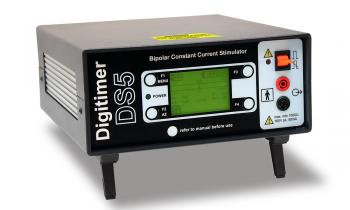DS5 Isolated Bipolar Constant Current Stimulator
The Digitimer DS5 isolated bipolar DC stimulator works under the control of the computer program, repeating the shape of the generated impulses. It's a CE marked medical device under the European Medical Device Regulation.
- Overview
- Specifications
- References
- Links
FEATURES
- From a compliance of ±120V, up to ±50mA can be supplied in 3 output ranges.
- Proportional to the input "command" voltage with an isolated constant current output
- Designed for use in nerve excitability assessment with QtracW
- Compatibility with DAQs that can generate an analog voltage output
- Protecting patients and human subjects is ensured by safety elements. It's a medical equipment with a CE mark
The maximum constant current output of the DS5 Isolated Bipolar Constant Current Stimulator is ±50mA, and it has computer controllable stimulus amplitude and timing parameters. It was initially created to facilitate semi-automated nerve excitability tests, which would hasten and improve human peripheral nerve diagnoses. However, it also plays a part in broader areas of clinical neurophysiology research, such as nociceptive, vestibular, and psychological testing. According to the European Medical Device Regulation, the DS5 Isolated Bipolar Constant Current Stimulator is a medical device with a CE certification.
The DS5 is driven by an analog voltage input, or "command" signal, which it converts into an isolated constant current stimulus (up to ±50 mA), faithfully reproducing the input waveform. As a result, anyone who wants to manage surface electrical stimulation protocols using software/hardware combinations that can generate a suitable command voltage waveform, such as semi-automated pain research or sensory threshold testing, may be interested in the DS5. The DS5 has also been used in transcranial AC stimulation (tACS) and galvanic vestibular stimulation (GVS) protocols.
The DS5 was created in association with Prof. Hugh Bostock (UCL, London) for use with QtracW, a program from Digitimer that controls nerve excitability stimulus, acquisition and data analysis.
ACCESSORIES
Supplied
- Mains (Power) lead
- OperatorÆs Manual
- USB Cable
Recommended
- D185-HB4 Output Extension Cable
- D185-OC1 û Output Plugs
- Electrodes and electrode adaptor leads
The instrument was used in these investigations:
- Heart-brain interactions shape somatosensory perception and evoked potentials.
Al, E., Iliopoulos, F., Forschack, N., Nierhaus, T., Grund, M., Motyka, P., ? Villringer, A.
(2020). Proceedings of the National Academy of Sciences of the United States of America, 117(19), 10575?»10584. - tACS motor system effects can be caused by transcutaneous stimulation of peripheral nerves.
Asamoah, B., Khatoun, A., & Mc Laughlin, M.
(2019). Nature Communications. nature.com. - The neural circuitry of affect-induced distortions of trust.
Engelmann, J. B., Meyer, F., Ruff, C. C., & Fehr, E.
(2019). Science Advances. advances.sciencemag.org.
You can also visit site of the manufacturer.


